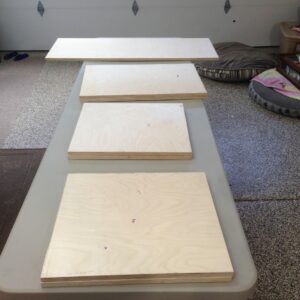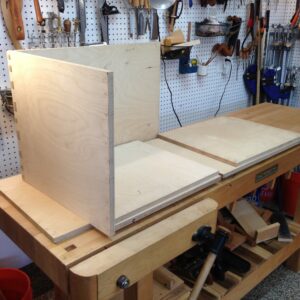using hand plane to smooth baltic birch plywood
The question I have is finishing Baltic Birch plywood. I would strongly prefer to use a finely set hand plane (and will try it on a scrap piece) rather than sand it. Have any of you used a hand plane to give a final smoothing on Baltic Birch? If so, did it work well for you?
I am getting close to completing a large, dovetailed Baltic birch plywood box for my nephew for a big subwoofer in the back of his Suburban (he’s into audio equipment) and I’ve been following a plan for the construction. The dovetails and shellac finish are my choices to make it slightly nicer.
I rarely sand anything as I prefer to use a freshly sharpened hand plane with a fine setting for smoothing the wood before I apply shellac. I’ve asked Paul Sellers, Bob Rozaieski, and Mike Pekovich/Ben Strano (via Shop Talk live) about putting shellac over a hand planed surface and all are fine with doing so.
Thanks for the feedback. This large size and working with plywood has been all new learning for me and is fun.
Update 22Oct2022
Dear all,
Thanks for the feedback. Today, I took a scrap of Baltic birch plywood and used a sharp No 3 hand plane and smoothed no. Shavings were on the order of one thou. Did about 5 to 8 passes (more than I will likely do on finished piece). No tear out, didn’t go through the ply. It came out really smooth. This is how I will finish the actual item given how well it worked.
Sincerely,
Joe
















Replies
I understand liking planing or scraping vs sanding, but for rotary cut plywood? Seems a waste of time, for the rotary plywood reason, as well as the fact that it's going to live in the back of a Suburban.
Ditto on all that!
Can you please elaborate on what you mean regarding it being rotary cut plywood? I'm fairly ignorant as to plywood other than Baltic birch has lots of plys and is typically nearly void free.
As for it being in the back of a Suburban, I'm fine with that. He's a good nephew and has helped us a lot over the years without asking for anything in return. Happy to make him something that he is excited about. We likely talked about it for close to two years before he got the plywood.
Rotary means they peel the log, rolling the log as the wood is shaved off. The grain direction of that ply you want to plane changes over and over again, making planing very difficult. High grade hardwood plywood is sliced from the log, making repeated book-matched slices that are butted together as the top ply.
I think you’re playing with fire. Those veneers are pretty thin. Birch can also be a little tear out prone. Also, shellac will kinda negate any effect a planed finish will give. When I think planed finish I think linseed oil and wax.
Thanks regarding birch being prone to tearout. Will try using my plane that has a 55 degree frog in it on the scrap. The choice of shellac is based on my showing him some pine that I finished with garnet shellac. I will make a sample board with some shellac. I will also try linseed oil (via Tried and True that I already have) to see what it looks like with and without a top coat of garnet shellac.
I did a stereo stand for my son with baltic when it was still available. I just sanded it and used wipe on poly, came out fine. No way would I use a hand plane on a ply surface, a card scraper maybe, but very carefully. Ply is not solid wood.
It will tear out. Mark your surfaces and take it back to the tablesaw, or glue it up, put some masonite under it and take the whole box to the tablesaw, then get out the sander.
If you do the latter you can back-bevel the corners slightly and they will slide on the truck carpet better without tearing off the surface veneer.
Thanks. Will make sure to put a heavy back bevel/chamfer on the bottom.
I don't think planing birch plywood is a very good idea. The veneer is thinner than the surface irregularities, so the flattening effect of planing would potentially eat thru the veneer in places. And you wouldn't know if this was going to happen until you had all the joints cut. A card scraper would be about all I would use.
The comments about radial cut veneer concern that fact that the veneer is bent fairly sharply coming off the cutting knife, and doesn't really behave like solid wood any more. It's been fractured along the grain, but still holds together enough to be glued to the substrate. Flitch cut veneers are a very different animal. Because of the fracturing, rotary cut veneer is much more porous, absorbing finish a lot more, and taking more coats to get smooth. And the grain raises more. I have sanded the (officially already sanded) birch plywood, then applied Waterlox Transparent, a wiping varnish, and the surface is always rougher than when I use Waterlox on solid wood.
So, try a card scraper and see if it helps. Let us know what you find out!
Thanks. I do have both a card scraper and a No. 80 cabinet scraper. Will try those on scrap cutoffs to see how they all perform. If I'm not happy how that all works, then, I will just sand it.
You can plane it, but you only get one pass.
It's a subwoofer box. Don't make a clock of it.
Make a simple project more complex that it needs to be? I would never do that, lol.
Listen to the advise. You don't go near plywood with a plane, or any kind of scraper.
So go ahead, and if for some reason you're happy, if you don't ruin your project you'll be lucky.
Nothing less than 220 grit sandpaper, and do it by hand unless you've got some experience with a random orbital!
Thanks. I will try some scrap with hand plane and scraper just to see how it behaves. Based on what I've seen, I don't expect it to go well and most likely will end up using sandpaper. I don't a random orbital sander so it will have to be by hand. I do own a piece of cork so that will help. Won't take that long to sand by hand. I agree, 220 grit minimum.
This forum post is now archived. Commenting has been disabled